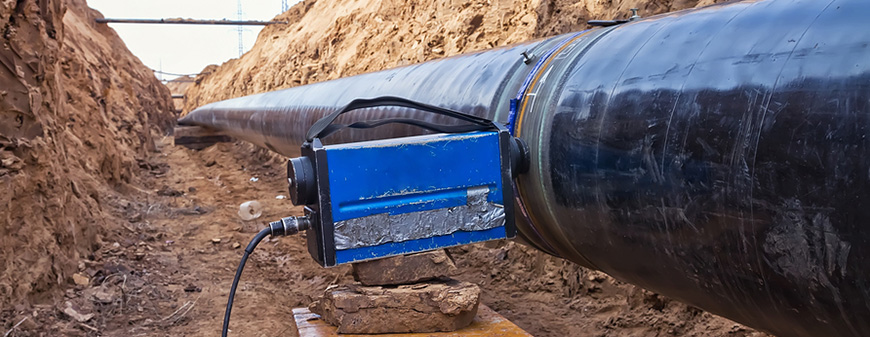TWS is a Great Training Option for Everyone
Learn more about how we can prepare you to advance your career.
Did you know welding is the most common way to permanently fuse metal parts? That’s right. This age-old craft is employed in more than half of the goods manufactured in the U.S.[1] You can’t go far without seeing the products of the wide world of welding. They’re in everything from ships to airplanes to highways, buildings and bridges.[2]
But not all welded joints are as strong as they should be. Some welds have discontinuities and defects that can cause them to fail.[3]
How can welding professionals ensure the skyscrapers and automobiles they produce are safe for the public? Nondestructive testing allows them to inspect, test and evaluate welded structures for discontinuities without destroying them.[4]
Radiographic testing is one of the most popular, important and versatile forms of nondestructive examination. Discover more about the technique below.[5]
Have You Considered a Career in the Skilled Trades?
Fill out the form to recieve a no obligation info packet.
How Does Radiographic Testing Work?
Unlike destructive testing methods in which the completed weld is broken in order to evaluate its mechanical properties, radiographic testing leaves the finished product intact.
With this approach, X-rays are used in a similar fashion as in the medical field; in both industries, inspectors can use electromagnetic radiation to view the internal composition of a structure without taking it apart.[6],[7]
Here’s how the process of radiographic testing works in welding:
Step 1: A radioactive isotope produces gamma rays or X-rays.
Step 2: The radiation is sent through the weldment onto photographic film.
Step 3: An image of the internal structure of the weldment is created on the film.
Step 4: Darker areas of the image reflect thinner portions of the weldment, suggesting discontinuities like cracking or porosity, a common welding mistake. Lighter areas of the film may suggest high density inclusions, such as tungsten.
Step 5: Radiographic interpreters trained to read the films and identify weld discontinuities by the shape and variations of dark and light examine the test results.7
What Are the General Advantages and Disadvantages of Radiographic Testing?
There are many general benefits to radiographic testing, as well as some drawbacks.
Radiographic Testing Advantages
- Radiographic testing is a positive approach for finding porosity, cracks, inclusions and voids in the inside of weldments.
- Surface and subsurface defects can be uncovered.
- Dimensions and angles within the sample can be measured without sectioning.
- Subtle changes in corrosion, thickness, material density and flaws can be detected.7,[8]
Radiographic Testing Disadvantages
- Must be conducted by a qualified radiographic interpreter.
- False interpretation can interfere with productivity and be costly.7
What Are the Different Types of Radiographic Testing?
There are two main types of radiographic testing: conventional radiography and digital radiography. The digital approach has multiple variations. Each method has its pros and cons.
Conventional Radiography
As described above, this form uses radiation and sensitive film to capture images of the inside of welded goods and structures.
Pros:
- The method provides a permanent film record of weld quality.
- Reveals flaws or defects in a weldment.
Cons:
- The film can be used just once.
- Processing and interpreting the films can be time consuming.
- Invisible to the naked eye, gamma and X-ray radiation can cause serious health problems.7
Digital Radiography
Instead of using film, digital radiography displays the images of the weld’s interior on a computer screen.
Pros:
- Quick exposure and interpretation time.
- Higher-quality images.
- Multiple applications: detecting defects in materials, inspecting weld repairs, identifying corrosion under insulation and finding foreign objects in systems.[9]
Where Is Radiographic Testing Used?

Radiographic testing is employed to inspect welds in the following industries:
- Transportation
- Automotive
- Aerospace
- Offshore
- Power generation
- Military
- Marine
- Waste management
- Petrochemical8
- Medical Devices
- Packaging[10]
- Manufacturing
Welding Quality Assurance and Public Safety
Since welding is used in the manufacture and construction of so many products and structures found in society, it’s crucial that safety measures are put in place to keep the public safe.
Destructive and nondestructive testing are two forms of quality assurance in welding. Radiography is a useful method of nondestructive testing that you may learn more about as you advance in your welding program.
Additionally, the field of quality assurance presents advanced career paths in welding; two examples are welding interpreters and welding inspectors.
[1] https://weldingcareernow.com/articles/12-interesting-facts-about-welding
[2] https://www.bls.gov/ooh/production/welders-cutters-solderers-and-brazers.htm#tab-2
[3] https://www.slideshare.net/nimatajallipour/weld-defects-and-discontinuities
[4] https://www.asnt.org/MinorSiteSections/AboutASNT/Intro-to-NDT.aspx
[5] https://awo.aws.org/2014/12/what-does-a-certified-radiographic-interpreter-do/
[6] https://www.merriam-webster.com/dictionary/Xray
[7] https://www.esabna.com/us/en/education/blog/radiographic-and-ultrasonic-testing-of-welds.cfm
[8] https://www.twi-global.com/what-we-do/services-and-support/asset-management/non-destructive-testing/ndt-techniques/radiography-testing
[9] https://inspectioneering.com/tag/radiography
[10] https://jgarantmc.com/industrial-radiography-applications/
This blog has been labeled as archived as it may no longer contain the most up-to-date data. For a list of all current blog posts, please visit our blog homepage at https://www.tws.edu/blog/







